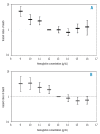Association of mild anemia with hospitalization and mortality in the elderly: the Health and Anemia population-based study
- PMID: 19001283
- PMCID: PMC2625429
- DOI: 10.3324/haematol.13449
Association of mild anemia with hospitalization and mortality in the elderly: the Health and Anemia population-based study
Abstract
Background: Mild anemia is a frequent laboratory finding in the elderly usually disregarded in everyday practice as an innocent bystander. The aim of the present population-based study was to prospectively investigate the association of mild grade anemia with hospitalization and mortality.
Design and methods: A prospective population-based study of all 65 to 84 year old residents in Biella, Italy was performed between 2003 and 2007. Data from a total of 7,536 elderly with blood tests were available to estimate mortality; full health information available to evaluate health-related outcomes was available for 4,501 of these elderly subjects. Mild grade anemia was defined as a hemoglobin concentration between 10.0 and 11.9 g/dL in women and between 10.0 and 12.9 g/dL in men.
Results: The risk of hospitalization in the 3 years following recruitment was higher among the mildly anemic elderly subjects than among subjects who were not anemic (adjusted hazard ratio: 1.32; 95% confidence interval: 1.09-1.60). Mortality risk in the following 3.5 years was also higher among the mildly anemic elderly (adjusted hazard ratio: 1.86; 95% confidence interval: 1.34-2.53). Similar results were found when slightly elevating the lower limit of normal hemoglobin concentration to 12.2 g/dL in women and to 13.2 g/dL in men. The risk of mortality was significantly increased in mild anemia of chronic disease but not in that due to beta-thalassemia minor.
Conclusions: After controlling for many potential confounders, mild grade anemia was found to be prospectively associated with clinically relevant outcomes such as increased risk of hospitalization and all-cause mortality. Whether raising hemoglobin concentrations can reduce the risks associated with mild anemia should be tested in controlled clinical trials.
Figures



Comment in
-
Prognostic implications of anemia in older adults.Haematologica. 2009 Jan;94(1):1-2. doi: 10.3324/haematol.2008.001289. Haematologica. 2009. PMID: 19118372 Free PMC article.
References
-
- Salive ME, Cornoni-Huntley J, Guralnik JM, Phillips CL, Wallace RB, Ostfeld AM, et al. Anemia and hemoglobin levels in older persons: relationship with age, gender, and health status. J Am Geriatr Soc. 1992;40:489–96. - PubMed
-
- Anía BJ, Suman VJ, Fairbanks VF, Rademacher DM, Melton LJ., III Incidence of anemia in older people: an epidemiological study in a well defined population. J Am Geriatr Soc. 1997;45:825–31. - PubMed
-
- Guralnik JM, Eisenstaedt RS, Ferrucci L, Klein HG, Woodman RC. Prevalence of anemia in persons 65 years and older in the United States: evidence for a high rate of unexplained anemia. Blood. 2004;104:2263–8. - PubMed
-
- Carmel R. Anemia and aging: an overview of clinical, diagnostic and biological issues. Blood Rev. 2001;15:9–18. - PubMed
-
- Nissenson AR, Goodnough LT. Anemia. Not just an innocent bystander? Arch Intern Med. 2003;163:1400–4. - PubMed
Publication types
MeSH terms
LinkOut - more resources
Full Text Sources
Medical

